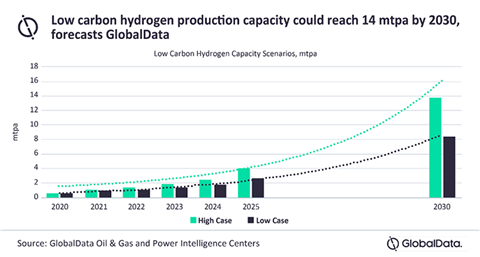Global hydrogen capacity to reach 14 mtpa in 2030, study shows
August 05, 2021

The global capacity for hydrogen production from renewable energy or natural gas with carbon capture could reach 14 million tons per year (mtpa) by 2030, an increase of 20 times current levels, a data and analytics company reported recently.
In its latest report, “Hydrogen Transition Outlook and Trends – Q3 2021,” GlobalData said that potential production could increase even further, to 20 mtpa, if all projects in the pipeline come to fruition.
Of this capacity, about 85% is from “green hydrogen,” which is produced from renewable energy. The remaining 15% is from “blue hydrogen” projects, which produces hydrogen from gas and are equipped with carbon capture technologies.
The majority of the capacity in the pipeline comes from projects that are still in the feasibility stage and not certain to go ahead. GlobalData’s 2030 outlook envisages low carbon hydrogen capacity reaching 14 mtpa in a high case scenario while the low case scenario would see more measured growth to 8 mtpa, though still over 10 times higher than the currently active capacity of 0.6 mtpa.
‘‘Low carbon hydrogen can offer path to reduced emissions in the refining and chemicals sectors, as well as decarbonization of hard to abate sectors such as heavy transport and industry,” said Will Scargill, managing energy analyst at GlobalData.
“The sector has the potential for rapid growth this decade, with green hydrogen leading the charge. However, the pace will depend on progressing major projects through to investment, particularly as the pipeline is relatively top-heavy with the top 10 projects representing 65% of pipeline capacity.’’
In addition to progressing production capacity developments, key determinants of low carbon hydrogen sector growth will be policy support and development of the wider value chain. The EU announced an ambitious hydrogen strategy last year and many governments globally are developing policies to capture a share of this growth market and accelerate their own energy transitions.
Partnerships are also springing up between companies representing different parts of the value chain to build a coherent strategy for development. This includes collaborations between companies developing production capacity and those with potential customers to underpin these developments. Q2 2021 alone witnessed over three times the number of hydrogen-related partnership deals as in the first half of 2020.
“A rapid build out of the low carbon hydrogen sector will rely on a collaborative effort between companies and with governments. This should allow commercialization of the sector by developing new demand segments alongside capacity, scaling up technologies and bringing costs down,” Scargill said.
MAGAZINE
NEWSLETTER

CONNECT WITH THE TEAM








